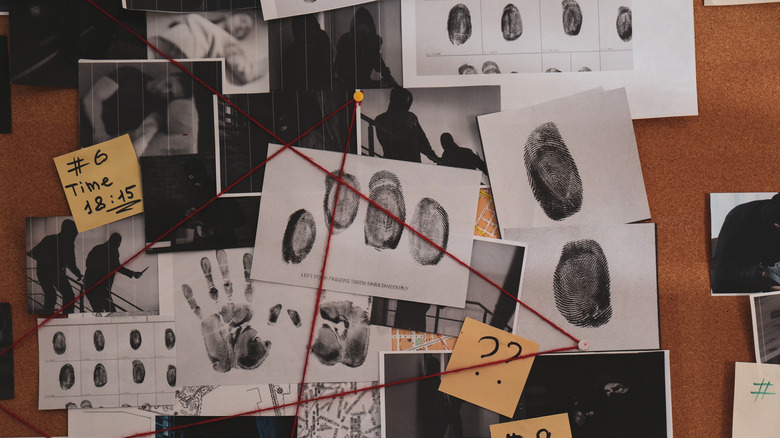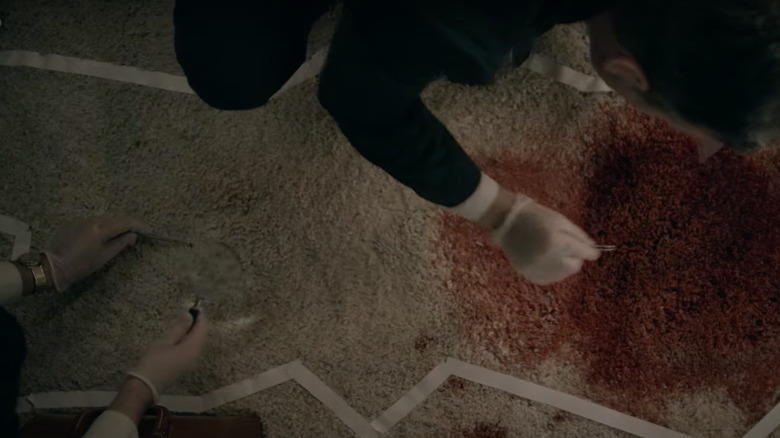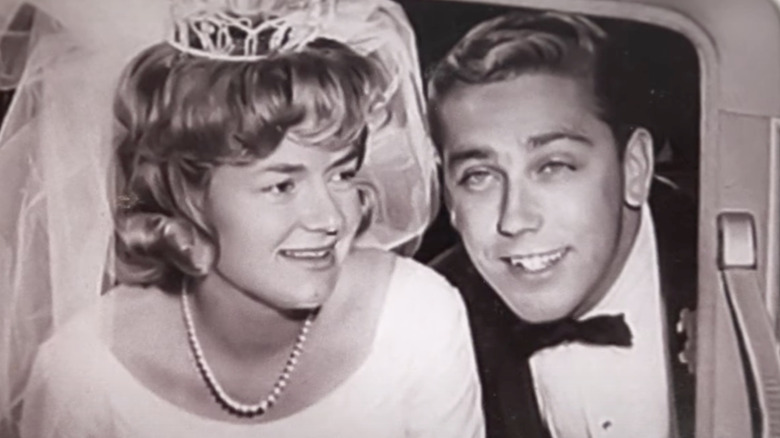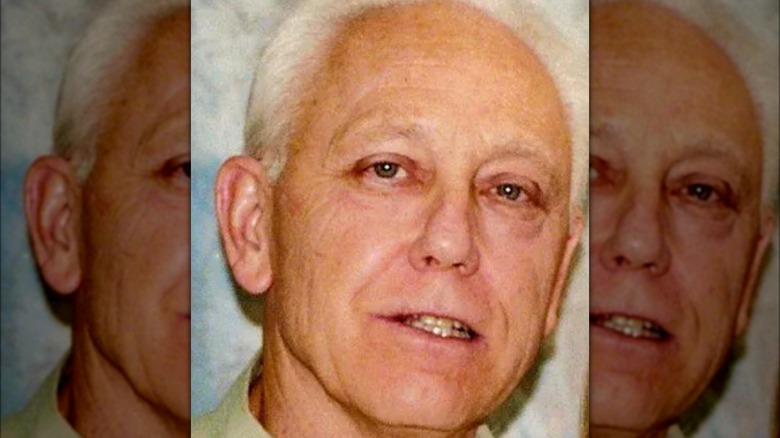The Truly Horrific Crime Scene Of The Jeffrey Macdonald Murders
This article contains descriptions of graphic violence.
It was cold and rainy in Fort Bragg, North Carolina on February 16, 1970. It seemed unpleasant but forgettable, an unfortunate but inevitable product of late winter weather. But unlike many of its ilk, this night, in particular, would not fade into obscurity. It would be remembered as the night of one of the most horrific and mind-boggling murders in American history.
It was on this army base where a young Green Beret and medical doctor named Jeffrey MacDonald lived with his pregnant wife, Colette, and their two young daughters, Kimberley and Kristen. As detailed by Vanity Fair in 1998, the Macdonalds' home was a modest one-story garden apartment. Their lives seemed very ordinary — until everything changed.
In the early hours of February 17, 1970, Jeffrey placed an emergency call. "We've been stabbed," he told the operator as he panted into the receiver. "People are dying." The call ended shortly afterward, and the Military Police, known as MPs, quickly went to the scene. It was eerily quiet as they entered the house, but what they saw horrified them. In the master bedroom, Jeffrey was lying next to his wife on the blood-covered floor with a puncture wound on his chest. He was alive, but barely. His wife was not. She was found with multiple stab wounds in her chest and neck and a fractured skull. On the headboard, "PIGS" was written in capital letters in blood.
The investigation into the Macdonald murders went from bad to worse
After discovering Jeffrey Macdonald with the body of his wife, Colette, MPs entered the rooms of their two daughters, Kimberley and Kristen. Five-year-old Kimberley was found lying on her bed, the victim of a vicious clubbing, according to The Washington Post. Her 2-year-old sister suffered a similar fate, along with over two dozen stab wounds. As described by the 1983 book "Fatal Vision" by author Joe McGinnis, a baby bottle rested near Kristen's mouth, a chilling reminder of the victim's youth.
The living room was similarly in disarray. A coffee table was upended and rested on its side over some magazines. A flower pot and a pair of blood-spattered glasses, belonging to Jeffrey MacDonald, had been knocked onto the floor.
But as horrifying as the crime scene was, it had nothing on the story Jeffrey recounted about that night to the MPs at the scene. According to the 26-year-old father, he had been sleeping on the couch when he heard a scream and saw four intruders looming over him: two white men, a Black man in army attire, and a woman with long blonde hair and a wide-brimmed floppy hat, per USA Today. Per Jeffrey's account, the woman had allegedly held a candle while chanting phrases such as "kill the pigs" and "acid is groovy." As she recited the same words over and over again, Jeffrey alleged fought with the men, but was overpowered.
Some things didn't add up about Jeffrey Macdonald's story
Because the crime had occurred on military property, the Macdonald murders' case was handled by the army's Criminal Investigation Division, more commonly known as the C.I.D. The unit quickly deduced that elements of Jeffrey Macdonald's story didn't add up.
Aside from the upended coffee table and potted plant, the living room was fairly pristine. Jeffrey MacDonald claimed that he had taken off his shirt before going into his daughters' rooms, but there were dozens of his pajama shirt fibers found in Kimberley's sheets. Fibers were also found in Kristen's room, including one under her fingernail — a tell-tale sign of a struggle. The glove that had been used to write "PIG" on the headboard matched a box of cleaning gloves under the kitchen sink. Moreover, the wound Jeffrey sustained was described as "clean, small, sharp" by a staff surgeon, per Vanity Fair – as if the military doctor had deliberately injured himself without inflicting long-lasting damage.
However, perhaps the strangest part of the crime scene had to do with the magazines found in the living room: One contained a feature on the Charles Manson murders, which had occurred less than a year prior. The fact that MacDonald blamed drug-addled hippies for the crime — ones who seemed to operate in eerily similar ways to members of the Manson Family — seemed a tad too difficult to ignore.
A blood anomaly unlocked surprising details
It wasn't just the initial evidence that poked holes in Jeffrey MacDonald's story. As Vanity Fair noted in 1998, Each member of the family had a different blood type — a major statistical anomaly that proved to be vitally important. In 1970, medical technology could not extract DNA from blood, so in most cases, it was almost impossible to distinguish what blood came from which person if the victims were of the same type. The fact that each member of the MacDonald family had a different blood type allowed investigators to map out who had been where — and the result didn't align with Jeffrey MacDonald's story.
After conducting an analysis, investigators found Kristen's blood on Jeffrey's glasses, even though he claimed he had taken them off before going into her room. Additionally, Colette's blood was found in Kristen's room, suggesting that she had been attacked in more than just the master bedroom. Following the blood pattern, authorities put together a new hypothesis, and it was horrifying.
They believed that Colette and Jeffrey had been involved in an argument that eventually turned physical and that Colette had hit her husband on the forehead with a small object, like a hairbrush. Jeffrey then retaliated by clubbing his wife with a stray piece of lumber in the house. Kimberley had then heard the ruckus, went out to investigate, and was accidentally hit during the scuffle, resulting in a lethal head wound.
A desperate coverup leads to more bloodshed
Believing that Colette Macdonald was dead, authorities speculated that Jeffrey Macdonald (pictured above) carried his 5-year-old daughter, Kimberley, to her bedroom, per Vanity Fair. However, he soon realized that her wounds were likely fatal, thanks in part to his medically training. It was at this point that Jeffrey allegedly knew he had to finish the job, and subsequently staged the house to look like a murder scene. The C.I.D. hypothesized that he then killed Kimberely, and the shirt he said he wasn't wearing on the night of the murders was, as a result, spattered with her blood. As authorities further theorized, if Jeffrey wanted to sell a story about a violent home invasion, he also had to attack his youngest daughter, Kristen — which, per their hypothesis, he ultimately did.
Tragically, the C.I.D. noted that they believed that Colette — whom Jeffrey had thought was dead — revived herself and rushed to protect her little girl. They argued that she managed to make her way into Kristen's room but was overpowered, which would explain Colette's blood in Kristen's room. Jeffrey then allegedly returned his dead wife's body to the master bedroom.
Though the C.I.D. believed they had a strong case, it had some weak spots. Most glaringly, according to Vanity Fair, a witness had claimed to see a Ford Mustang with four people, including a blonde woman in a floppy hat, pull up to the MacDonald house the night of the murder.
A key witness threw a wrench into the Macdonald case
According to Vanity Fair, the woman in the floppy hat was eventually identified as Helena Stoeckley years after the murders took place — and after a lengthy search, she was finally tracked down by investigators. Though detractors claim she was manipulated into a confession by way of unethical interrogation methods, per Oxygen, she confessed that she, along with five men, committed the murders. She also claimed that Jeffrey MacDonald's refusal to give medicine to drug addicts had spurred them to "annihilate the MacDonald family."
In addition to this, Stoeckley gave a chilling reason for why Jeffrey was the only member of the family to survive. "Human sacrifice involving a pregnant woman is the most prestigious for the cult members," she told authorities during her interrogation, per Vanity Fair — alluding to Colette Macdonald's pregnancy at the time of her death.
But there were issues with her testimony. It didn't match what Jeffrey MacDonald had described at all. Moreover, authorities believed that Stoeckley suffered from delirium and was unreliable due to her heavy narcotics use. In a final blow to MacDonald's case, Stoeckley ended up recanting her testimony and calling the trial a "mockery made of justice." Eventually, Jeffrey MacDonald was found guilty of the triple murders and is currently in prison.





